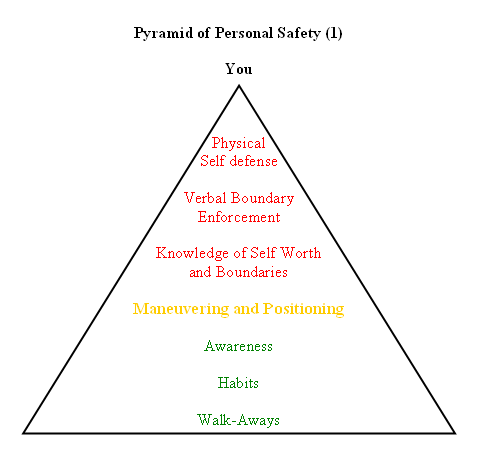
Personal Safety: Ideas before the Jab-Cross-Hook
by Brian Hamilton
Personal Safety is a phrase I'm going to use in this paper. What I mean to infer, by that phrase, is a number of behaviors or set of actions that you can make part of your lifestyle to make your life safer. Why not say self-defense? I use Personal Safety, simply because I use it's foundation principles at all times not just in times of defense, hence the subtitle to this article. This implies that these behaviors are part of my daily routine. Incorporating these behaviors and ideas into one's lifestyle will make for a safer life and if you are in a situation you are uncomfortable with you will have options and choices before the jab-cross-hook.
Lots of people talk of self-defense, "street" fighting, "street" technique, "buy my video…"; whenever they talk about these things they equate the idea of personal safety and self-defense as one in the same: physical action; meaning you get sweaty and get moving. This creates the idea, even in advanced students, that personal safety involves physical action along the impacting and grappling route. Guess what? When you get to that, in multiple ways, you've already lost.
First, you've lost in a spiritual way. You have lost your discipline and control of the situation therefore you are involved in a physical confrontation. On a practical level, losing control of the situation has put you in harms way. Now you must ask yourself these questions: How many opponents are apparent? Are you sure there isn't more? Do they have weapons? What kind weapons are they? By that I mean are they long weapons (bats, pool cues, 2X4's, chairs etc.), edged/puncture style weapons (knives, broken bottles, ice picks, shives etc.), handloads (saps, blackjacks, quarter rolls, brassknuckles etc.) or even firearms? Anyone armed with more than one weapon? Weapons are like the potato chip; you can't have just one. How have you made it thus far? Being in a situation you can't control means the probability of getting harmed has just raised dramatically. Meaning have you been shot, stabbed or rendered unconscious yet? I hate to be the one to break it too you, but you're not as good as you think.

This pyramid is a model illustrating all aspects of Personal Safety from your lifestyle behaviors to a physical altercation. It is based on the very informative website of author and instructor Marc "Animal" MacYoung (1) as well as conversations and seminars with Guru Jeff Brown (2) and Guru Lee McKinney (3). You read this pyramid from the bottom; it is how to diagram your lifestyle for all around safety. In simplest terms the more narrow the triangle (i.e. the closer to the top) the more danger you face.
The following is a quick and concise explanation of what the pieces of this diagram mean from the simplest, broadest and safest behaviors through the progressively situation specific behaviors.
The color-coding is just like a traffic signal
Red = Stop/danger ahead. Red is a situation specific reaction that could quickly get out of your control unless you act swiftly to de-escalate them.
Yellow = be cautious. Yellow is the border between behaviors you have full control over and behaviors where you lose more and more options and need to take conscious action to de-escalate them.
Green = safe. Green is habits and behaviors you do regardless of the situation to increase your personal safety.
1) Walk-Aways: are things you do once you leave an area or situation. Locking doors, closing drapes, if you carry a purse or single strap bag carrying it across your shoulders to your other hip etc. These simple precautions serve as signs to would be burglars, attackers, stalkers etc. that you are making an attempt to protect yourself. Since criminals gravitate to the easiest targets these behaviors show you one. With these you can do more specific things like Habits.
2) Habits: are extenuations of Walk-Aways. Use common sense. Avoid walking alone at night, stay in the middle of the side walks, check alleys when walking by them, mind your body language by standing up straight and keep your eyes up to stay observant. A person staring at the ground appears submissive and not observant of their environment. Check around your car, parking lots are perfect for the common thief. Eventually you're going to have to turn your attention to the lock and in doing so, bend over and stop looking at everything else. This leads into Awareness.
3) Awareness: is crucial to your Personal Safety. If you walk around not paying attention, for example wearing headphones, you can be snuck up on by almost anyone. Back to the easy target point. Common criminals aren't criminals because they have a tremendous work ethic; they like easy targets. An aware target isn't an easy target. If you believe someone is walking after you in a crowd and following you or following you while you're driving your Awareness leads into Maneuvering and Positioning
4) Maneuvering and Positioning: This is an active response to a growing, perceived or direct future event. In plain English if it's 2 A.M. and you see a bar letting out rowdy people don't truck through the middle of the group, simply cross the street. If you feel you are being followed in a crowd make eye contact, briefly, with that person(s). It lets them know you see them and shows you are not submissive. Next, make a radical change in direction away from the person(s) you believe are following you and away from the direction you were moving (i.e. cross the street). If they aren't following you they are clueless and simply think you changed directions or don't even notice you. If they are they have to expose themselves by following you and your sudden change in direction. If they continue to follow you simply stay in a crowded area (they want to separate you from sources of help and/or witnesses) and find or call a law enforcement official. If you believe you are being followed while driving all you need to do is get on a main road (stay in a crowded area) and drive to the nearest law enforcement agency. If one cannot be found, do not start driving erratically or dangerously. Stay calm and use a cell phone to call a law enforcement agency. This naturally leads to your own Knowledge of Self-Worth and Boundaries.
5) Knowledge of Self-Worth and Boundaries: All violent acts start with intent (to act violently). The second aspect is opportunity (to act violently), which we can control. An attacker/aggressor (which can be anything from a mugger to a drunk) will see how far they can go with you. They will invade your personal space, make you feel uncomfortable and try to use that discomfort to physically control you. They may push you around the sidewalk and you may be walked right into an alley or they may get so close to you they can get your wallet or gain physical control of you. You can control and clearly define your boundaries, don't allow them to do the controlling. Walk past them and maintain an assertive but not aggressive body posture. Don't physically show them you're scared, even if you are. Hopefully this will work if, not you can use Verbal Boundary Enforcement.
6) Verbal Boundary Enforcement: is when defining boundaries and assertive body language isn't enough. The situation you are in is getting more and more dangerous. You're getting in trouble here and it needs to be stopped quickly and decisively. You need to keep moving and tell them to back off. Do not invade their space. They want conflict you don't; remember this. Verbal Boundary Enforcement is not aggression rather it is letting this person(s) know you aren't going to be an easy, much less willing target and/or participant in any activity with this person(s). Tell them to stay away, leave you alone or you will call law enforcement officials. Again, do not get involved in a verbal confrontation with this person(s); remember confrontation is what they want.
7) Physical Self-Defense: as a topic is very familiar to people who train martial arts. It is the impacting and grappling aspect of the martial arts. It is at this level where you are in a violent situation. Here you are in the absolute most danger. You need to use enough physical force to make an opening to escape; no more! Do not stick around and duke it out or give them the beating you feel they deserve. It isn't smart and may be illegal. Remember, your main goal is Personal Safety nothing more. Do what you need to be safe and that's all.
Once digested these behaviors can be easily integrated into your daily routine, training and mindset. The most important thing is remembering that keeping yourself safe does not begin with physically defending yourself with punches, kicks, etc. it ends with that. You have so many behaviors and choices before you ever get to that point. Knowing this you can use these behaviors to de-escalate situations, instead of thinking simply about physical confrontation and accidentally escalating the situation to that point. Now that you know the behaviors, there is no excuse not to use them and have greater Personal Safety.
References
(1) MacYoung, Marc. No Nonsense Self Defense. 3/30/03.
http://www.nononsenseselfdefense.com/
(2) Guru Jeff Brown. Seminar at Ohio University Mixed Martial Arts Club. 5/18/02.
(3) Guru Lee McKinney. Seminar at Ohio University Mixed Martial Arts Club. 3/8/03.
2003 OU Mixed Martial Arts Club
Ohio University - OU Club Sports